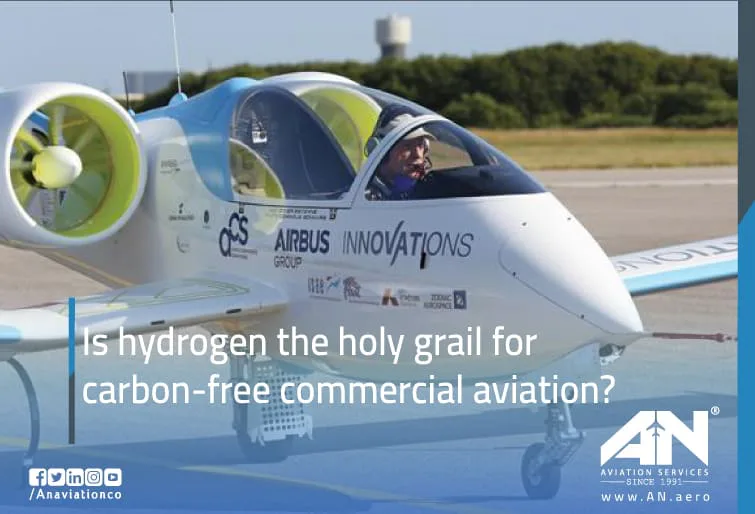
The aviation industry, a cornerstone of global connectivity, has long-faced scrutiny for its greenhouse gas emissions. As countries and industries alike strive for net zero by 2050, the search for a viable solution to carbon-free aviation is intensifying. Among the contenders—sustainable aviation fuels (SAF), electrification, and efficiency improvements—hydrogen-powered aircraft are emerging as a promising pathway to achieving true decarbonization in air transport.
But is hydrogen the ultimate answer to tackling the climate impact of aviation? Can it lead the industry toward a future free of fossil fuels while supporting the global demand for commercial flights? Let’s explore how hydrogen technology could shape the skies and its potential to become the “holy grail” of sustainable aviation.
The Climate Challenge in Aviation
Aviation contributes approximately 2–3% of global carbon dioxide (CO2) emissions, with aviation emissions rising in tandem with increased air travel demand. Aircraft rely heavily on jet fuel, a derivative of fossil fuels, which emits significant amounts of CO2 during combustion. As a result, the aviation industry is under pressure to reduce its carbon intensity while maintaining operational efficiency.
While sustainable aviation fuels (SAF) made from municipal solid waste or other renewable sources have made progress in reducing aviation emissions, the industry is still far from achieving widespread adoption of 100% SAF. Hydrogen, with its potential for zero CO2 emissions, presents a compelling alternative for carbon-free aviation.
Hydrogen-Powered Aircraft: How Does It Work?
Hydrogen can be used in aviation in two primary ways:
- Combustion Engines: Hydrogen can be burned directly in modified jet engines, producing water vapor as the primary byproduct instead of CO2. This method requires minimal adaptation of existing propulsion systems, making it a relatively straightforward transition for aircraft manufacturers.
- Fuel Cells: Hydrogen can also power electric motors via fuel cells, which convert hydrogen into electricity. This approach is particularly appealing for hydrogen-powered planes, as it eliminates harmful emissions entirely and achieves higher energy efficiency compared to combustion engines.
Both approaches have the potential to revolutionize the industry by enabling hydrogen-powered aircraft to operate without reliance on fossil fuels.
The Benefits of Hydrogen in Aviation
The appeal of hydrogen lies in its potential to completely eliminate carbon dioxide emissions during flight. As a fuel source, it offers several key advantages:
- Zero CO2 Emissions: Unlike traditional jet fuel, hydrogen does not release CO2 when burned or used in a fuel cell, making it an ideal candidate for carbon-free aviation.
- High Energy Density: Hydrogen contains more energy per unit of mass than traditional fuels, meaning it could power long-haul commercial flights with less weight, provided storage challenges are addressed.
- Compatibility with Renewable Energy: Hydrogen can be produced using renewable electricity through electrolysis, further reducing its carbon intensity and aligning with global climate goals.
- Adaptability to Emerging Designs: Advanced aircraft configurations, such as blended wing designs, are well-suited to hydrogen storage and propulsion systems, offering new possibilities for aircraft performance and efficiency.
Challenges in Hydrogen Adoption
While the promise of hydrogen is exciting, significant challenges must be overcome before it becomes a mainstream solution for commercial aviation:
- Infrastructure Requirements: Airports will need to develop extensive hydrogen production, storage, and refueling infrastructure, which represents a massive investment.
- Storage and Weight: Hydrogen is less energy-dense by volume than jet fuel, requiring larger and heavier tanks. This limitation is particularly problematic for long-haul and ultra-long-haul flights.
- Supply Chain Complexity: Creating a global hydrogen supply chain that is cost-effective and environmentally friendly will be a monumental task, especially in regions lacking renewable energy resources.
- Technological Maturity: While hydrogen-powered vehicles are already being developed, scaling this technology for large, long-range passenger aircraft will take years of research and development.
- Cost Considerations: Hydrogen production and storage remain expensive, making it challenging to compete with conventional fossil fuels and even sustainable aviation fuels in the short term.
Hydrogen vs. Sustainable Aviation Fuels (SAF)
Hydrogen is often compared to sustainable aviation fuels as a pathway to decarbonizing aviation. While both have distinct advantages, they cater to different applications within the industry.
- SAF: These fuels can be blended with existing jet fuel and used in current aircraft with no modifications, making them a practical short-term solution. However, they still emit CO2 during combustion and face supply chain challenges.
- Hydrogen: Hydrogen offers a truly zero-emissions solution but requires entirely new aircraft designs and infrastructure. It is more suited to long-term goals for carbon-free aviation.
Ultimately, the industry may adopt a hybrid approach, using SAF for near-term reductions in aviation emissions while investing in hydrogen for future innovation.
The Road Ahead: Net Zero by 2050
Achieving net zero by 2050 is a lofty but necessary goal for the aviation industry. Hydrogen could play a central role in this transition, particularly as governments and organizations prioritize funding for clean energy research. Projects like Airbus’s ZEROe program and other hydrogen-powered aircraft initiatives are paving the way for the next generation of sustainable aviation.
Collaborations between aircraft manufacturers, airlines, and policymakers will be essential to accelerate the adoption of hydrogen. This includes developing cost-effective fuel cell technologies, optimizing aircraft designs, and scaling up hydrogen production using renewable energy.
Conclusion
So, is hydrogen the holy grail for carbon-free aviation? While it is not a silver bullet, it is undoubtedly one of the most promising solutions for decarbonizing air transport. With its potential for zero-emissions commercial flights and compatibility with renewable energy, hydrogen stands out as a key contender in the quest to address the climate impact of aviation.
However, the road to widespread hydrogen adoption will require overcoming technological, logistical, and economic barriers. In the meantime, a combination of sustainable aviation fuels, efficiency improvements, and hydrogen innovation may be the most practical approach to creating a cleaner and more sustainable aviation industry.
The future of flying is one of bold innovation and collaboration, and hydrogen could very well be the fuel that powers us toward a greener horizon.

